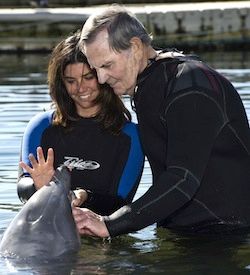Veterinarians care for animals patrolling the sea
Navy-trained dolphins, sea lions serve as animal soldiers protecting sailors and ships.

It’s almost midnight and the sea is dark. So dark that when the California sea lion spots a target, the enemy swimmer doesn’t know what hit him—until the clamp is around his leg and he’s being pulled in for interrogation.
“These animals are very stealthy underwater. You can’t hear them and you can’t see them,” says Sam Ridgway, DVM, PhD, DACZM, the Navy’s senior scientist for animal care and president of the National Marine Mammal Foundation.
Under Ridgway’s supervision, animal trainers teach sea lions in the U.S. Navy Marine Mammal Program to patrol for underwater threats, which they’re able to do because of their excellent diving capabilities, directional hearing and eyesight beneath the surface. At low light levels California sea lions can see about five times as well as humans, Ridgway says.
Ridgway is one of the founders of the Navy Marine Mammal Program and says it all started because of a dolphin named Tuffy. After Ridgway graduated from Texas A&M University College of Veterinary Medicine, he fulfilled his military obligation during the 1960 draft by entering the Air Force—he was told it had the best food.
Within a few years he’d heard about a missile base in Point Mugu, Calif., where Navy officers were studying dolphins. “It was rumored that dolphins could go very fast in the water. They thought the Navy might learn something that would help our submarines, torpedoes and ships go faster and easier through the water and use less energy,” Ridgway says.
He soon got involved with that work. He wanted to learn how deep dolphins could dive, so after training a particular dolphin named Tuffy, the Navy put the dolphin to the test. Many were skeptical and didn’t think Tuffy would return once he was let out to sea. “But in fact he always came back,” Ridgway says. “We learned he could dive at least 1,000 feet in the ocean, which was a lot deeper than people thought these bottle-nosed dolphins could dive.”
Navy officers soon discovered they could use dolphins’ cooperative nature to their advantage. In 1965 they employed Tuffy for a sea lab project involving aquanauts. The dolphin would dive down and bring rescue lines to divers pretending to be lost. He also carried mail and tools to and from the aquanauts. After the sea lab received positive recognition, Ridgway and his team worked with Tuffy to recover lost equipment and use sonar to detect sea mines so they could be avoided or removed.
“We also found that dolphins could hunt for enemy swimmers, who were causing a lot of trouble during Vietnam—blowing up barges, ammo ships and so forth,” Ridgway says.
That research led to training other marine mammals, and now nearly 60 animal trainers and eight veterinarians train and treat about 75 dolphins and 25 sea lions in the U.S. Navy Marine Mammal Program. The program is based San Diego, but the Navy transports the animals all over the world so they can serve where needed.
During Operation Iraqi Freedom, the Navy deployed dolphins to the Middle East where they cleared the channel of mines quickly so humanitarian ships could enter. If it weren’t for the trained dolphins, it would have been pretty dicey, says Ed Budzyna, a spokesman for the Navy’s Space and Naval Warfare Systems Center. The animal soldiers sped up the process in a situation where every second mattered and were a huge help, he says. “We take care of the animals so that the animals can keep our personnel safe,” Ridgway says. “That’s always been our mission.”
To teach the animals, trainers set up practice mines in San Diego Harbor. After a few exercises, the animals know exactly where the fake mines are. Ridgway says every few days they rearrange the course to make a different “Easter egg hunt.” He says the dolphins like to be challenged and exercise new skills.
It takes about three years before dolphins are ready for real mine-hunting. Ridgway says the Navy has never lost a dolphin in the line of duty and doesn’t ever want to lose one. That’s why they train dolphins to follow very careful, particular protocols.
Ridgway says veterinarians check on the animals frequently. “We cast eyes on them every day and trainers report any problems, because these animals will mask disease,” Ridgway says. “We have to know how to ask them when they don’t feel well. We’ll do lab tests and ultrasounds.”
Researchers are currently building underwater drones that will replace these dolphins’ duties at sea, which is why the Marine Mammal Foundation was created in 2007. When the drones are ready to be put into action—the projected year is 2020—the dolphins will revert to the foundation and the Navy will continue to care of them. Ridgway sees the dolphins as veterans, some of whom have served 40 years or more. “We think these animals are so valuable for learning about the ocean that they should have a role even after the Navy no longer needs them to hunt mines,” Ridgway says.
The foundation recently discovered that dolphins have a form of diabetes, but they seem to have a “switch” that turns it on and off, Ridgway says. Dolphins have a high fasting blood glucose level and when you feed them, they turn on insulin production, keeping their blood sugar at a set level. The Marine Mammal Foundation is studying this behavior in concert with a research institute in California.
“Because we’re a foundation responsible for medical care, we can help the animals and potentially help humans,” Ridgway says.